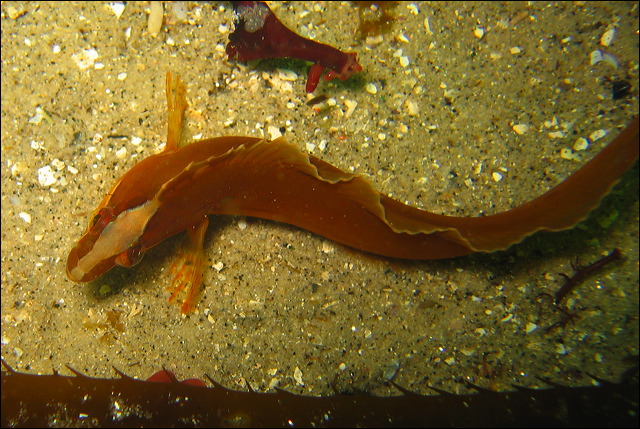Fish are aquatic vertebrates, the oldest, structurally simplest, and most abundant vertebrates, probably developed from an invertebrate similar to tunicates. They breathe through gills under water, are covered with scales, cold blooded, have lateral lines for water motion detection and fins that provide lift, maneuverability, stability (of course, there are exceptions to all these rules). Many aquatic animals are commonly called fish that are not fish but invertebrates, e.g. jellyfish, starfish.
Based on their skeletal composition fish may be grouped as: cartilaginous (Condrichthyes) and bony (Osteichthyes) fish. The first group contains sharks, rays, skates (this subclass is called Elasmobranchii). Their skeleton is made of cartilage, which is lighter and more flexible than bone. Their mouth is underneath the head, the rough skin is covered with placoid scales, also called dermal denticles, that have sharp tips. They have 5 - 7 gill slits without a cover and many species have a small opening behind the eyes, called a spiracle, used to pump water through the gills. Instead of swim bladder, sharks and rays use their large oil rich liver for buoyancy control. Rays and skates have flattened bodies as they are bottom dwellers, their pectoral fins are wing-like, gill slits are on the ventral side, while eyes are on the top of the head. The Ampullae Lorenzini are special sense organs of sharks and rays that can detect electro-magnetic fields, for example generated by their prey’s muscle contraction. The majority of fish are bony fish. Most have a swim bladder, a gas-filled sac, to adjust buoyancy, their single gill opening on each side have covers, called operculum. The largest bony fish is the sunfish, also known as mola mola, that can grow up to 5000 pounds.
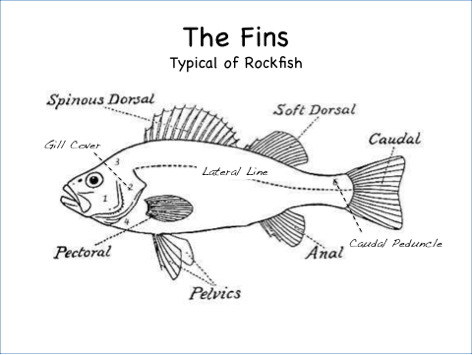
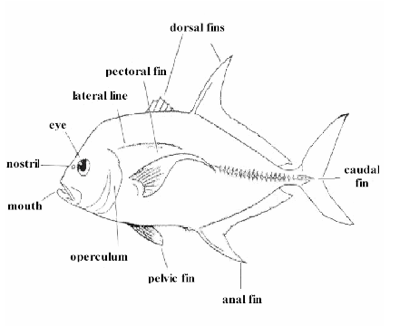
Fish have several fins: pectoral and pelvic fins are paired, dorsal, anal, and caudal fins are not. The dorsal fin, located on the back, is used for communication and defense, it often contains venomous spines. The caudal fin, also called the tail, provides propulsion. Sharks have asymmetrical (heterocercal) caudal fin. The shape of caudal fin may be rounded, forked, truncated, lunate. The anal fin, located behind the anus, provides stability. In Perches this fin is modified to transfer sperm into the female. The paired pectoral fins, located behind the gills, provide lift for tunas and sharks, other fish use them for swimming, resting on the bottom or even “walking”. The paired pelvic (or ventral) fins provide stability, and assist in changing direction. Some species develop suckers at the end of the pelvic fins to attach themselves to substrates. The modified pectoral fins in sharks are used to transfer sperm into females.
Most fish are carnivores, preying on other fish and invertebrates. They capture prey from the water column as well as sifting through the bottom sediment or over rock surfaces. Some are active predators, while others are filter feeders or even scavengers.
Fish are osmoregulators, i.e. they keep their blood at a constant salt level which may be different from the surrounding water, either sea or fresh. The blood of bony fish is less salty, they lose water by osmosis, so they must drink seawater to prevent dehydration. The excess salt is secreted by the kidneys and the gills. Sharks and rays developed a different strategy. They retain urea, a waste product from proteins that would be toxic to most other animals, to increase the solute concentration in their blood close to that of seawater.
Most fish have separate sexes, although some are hermaphrodites, either having both testes and ovaries, or change sex during their life time. For example, the local sheephead is born female but around age 7 she can change into a male. Most fish are oviparous, i.e. the eggs develop outside of the mother’s body. Fertilization usually takes place in the water column after simultaneous broadcast spawning of eggs and sperms. Exceptions, for example, are sharks and rays that perform internal fertilization using their claspers, a modified pelvic fin. Most spawning fish produce large number of eggs because only a small fraction survive in the plankton. The lucky ones briefly exists as larvae before metamorphosing into juveniles. Fish that produce smaller number of eggs guard them in nests (e.g. lingcod) or even brood them on their body (e.g. pipefish). Some fish (e.g. surfperch and several shark species), similar to mammals, are viviparous, i.e. the embryo develops inside the mother’s body which provides nutrition through the placenta. The juveniles are then produced by live birth. As they age the females will produce more offspring, therefore an older female population is beneficial in maintaining the species population. In very rare cases eggs can develop into an embryo even without fertilization, this phenomenon is called parthenogenesis.
- Shark/Ray
- Rockfish
- Surfperch
- Greenling
- Wrasse
- Bass
- Sculpin
- Goby
- Kelpfish
- Flounder
- Eel-like
- Mix
Shark/Ray
Triakis semifasciata - Leopard Shark
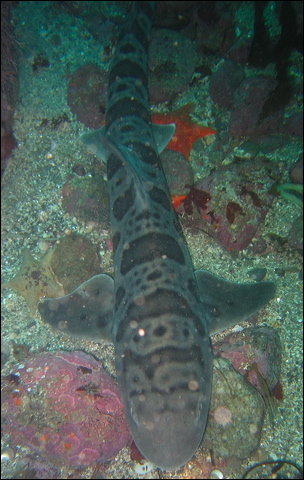
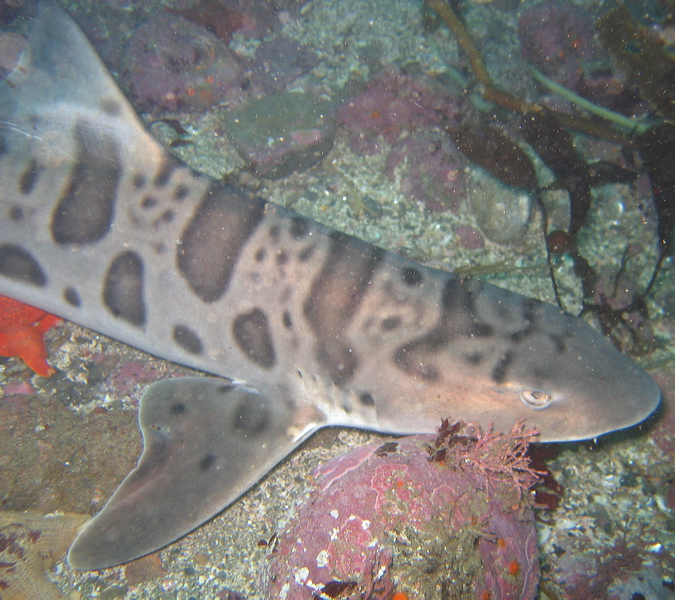
Torpedo californica - Pacific Electric Ray
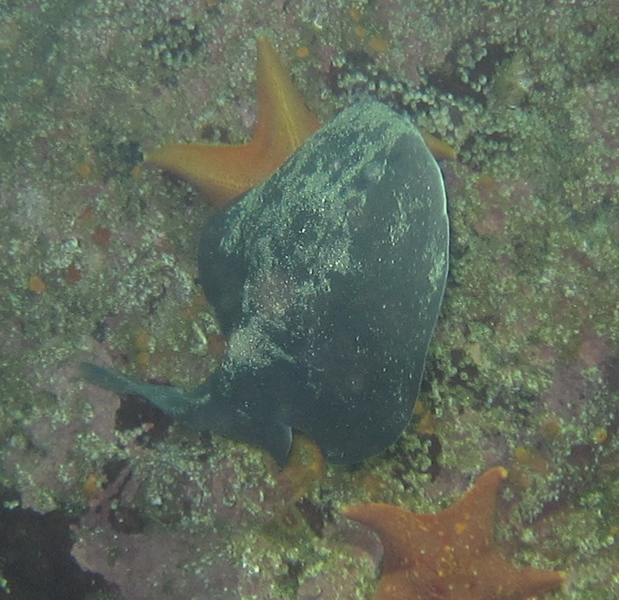
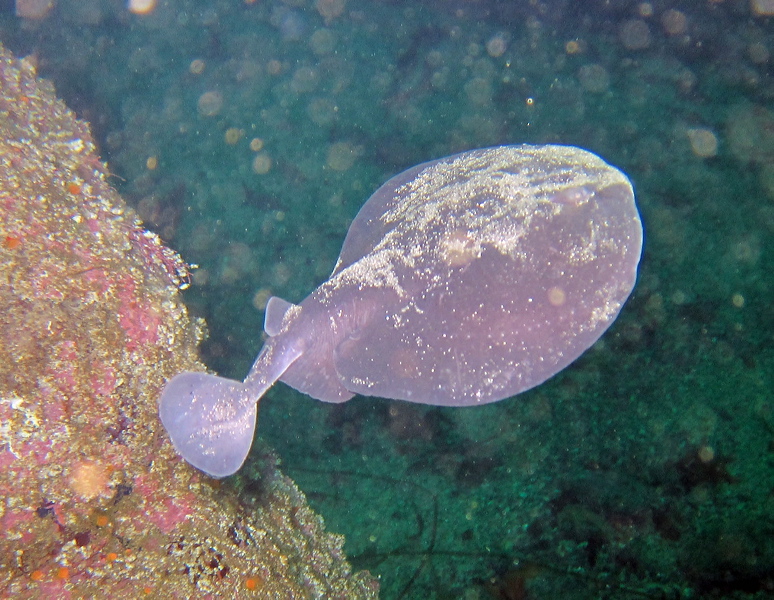
Platyrhinoidis triseriata - Thornback
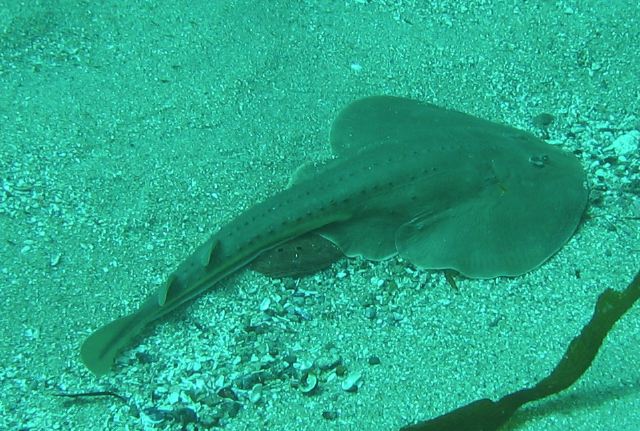
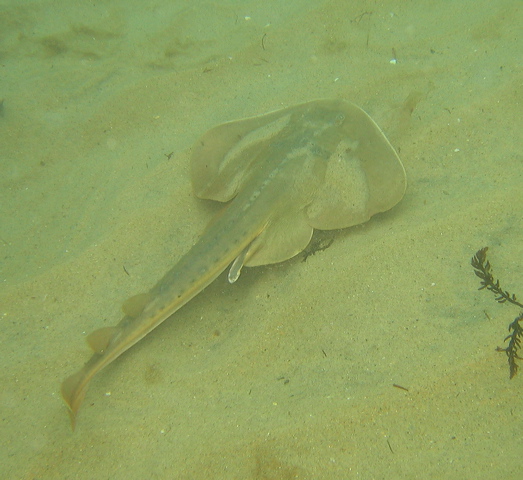
Myliobatis californica - Bat Ray
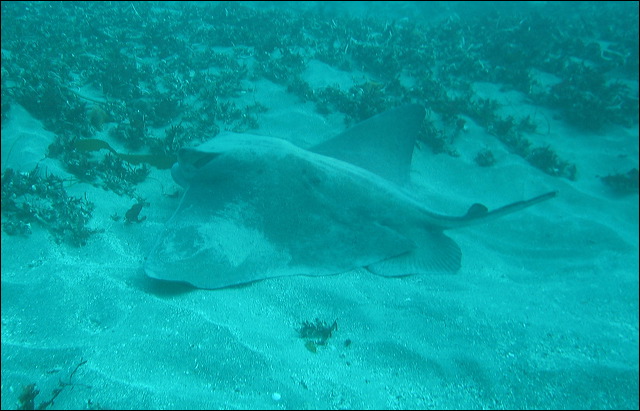
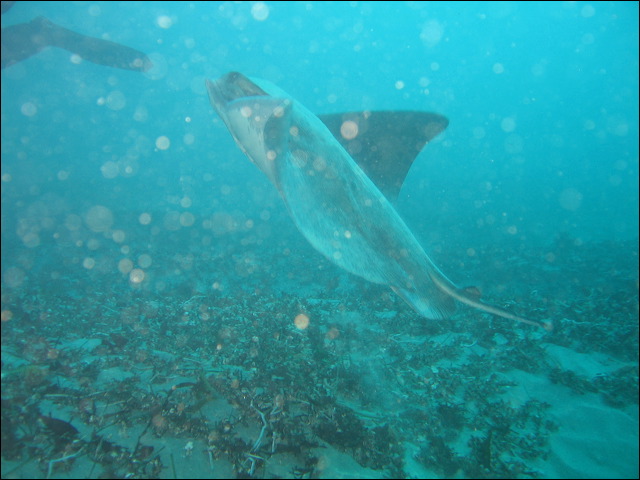
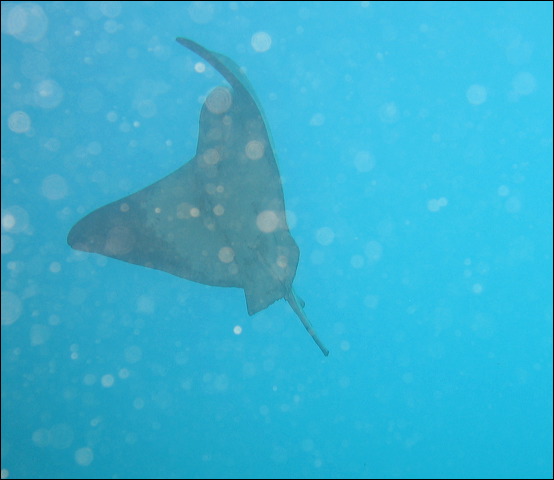
Swell Shark Egg Case (Mermaid’s Purse)
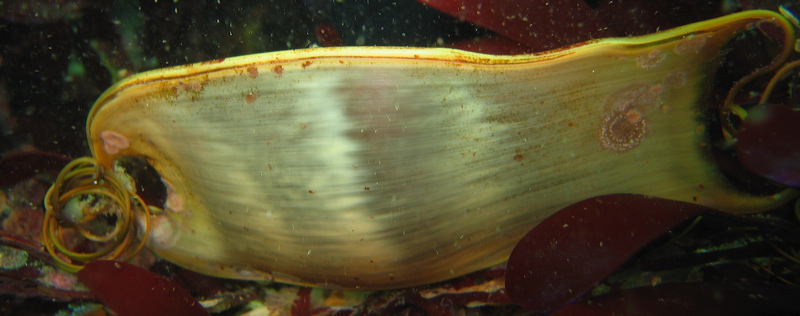
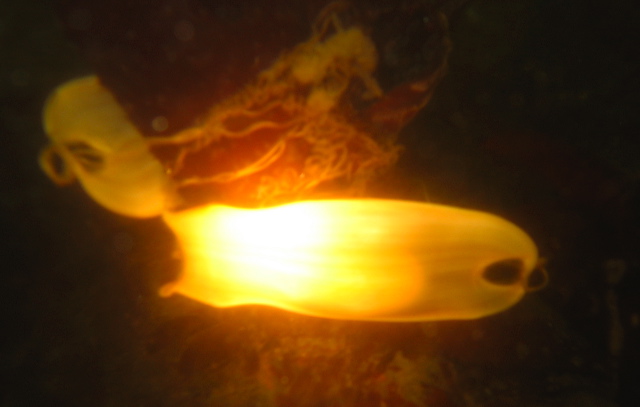
Rockfish – Scorpaenidae
The most common fish in our waters is the rockfish, there are more than 100 species in the North Pacific. They all belong to the same genus, Sebastes, means magnificent in Greek, indeed many are quite impressive with bright colors and bold markings. They have a stout, heavy body, ranging from 0.5 - 3 feet in size and a large mouth with prominent lips. Most can be found at shallow depth, but some, e.g. Starry rockfish, live below 100 feet. The average age is 10 – 20 years, but some, e.g. Canary rock fish, can live beyond 100 years. Some species, e.g. Blue or Yellowtail rockfish, form schools and hang high in the water column, while others, e.g. Gopher or China rockfish, are solitary and hide in crevices at the bottom. Their diet consists of crabs, shrimp, octopus, small fish.
Sebastes melanops - Black Rockfish
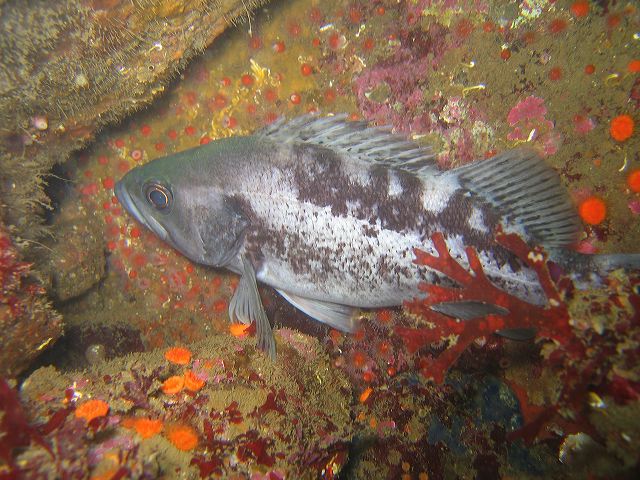
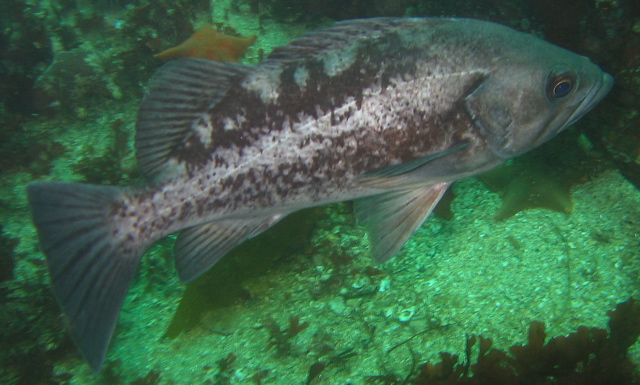
Sebastes chrysomelas - Black-and-Yellow Rockfish

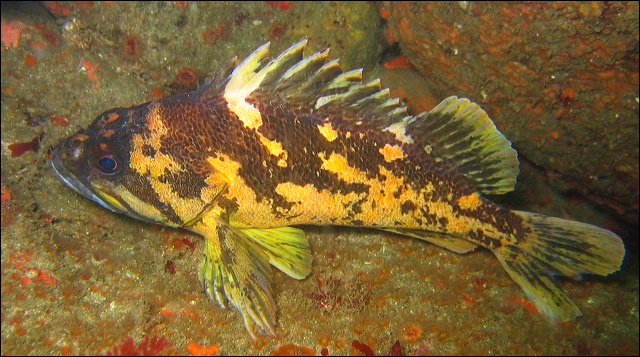
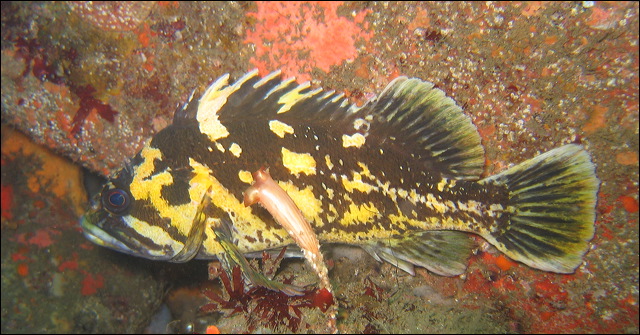
Sebastes mystinus - Blue Rockfish
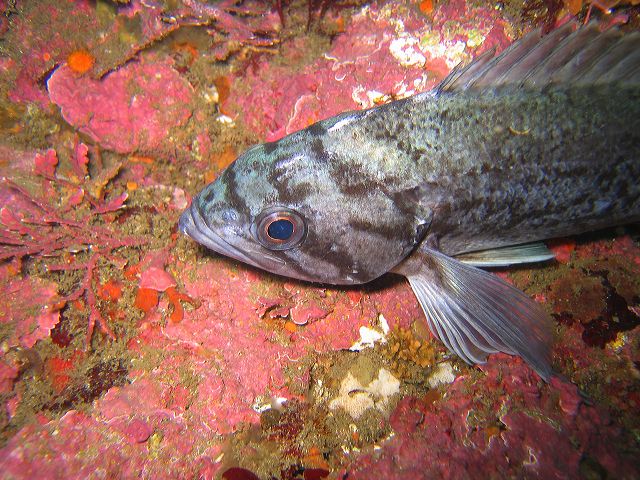
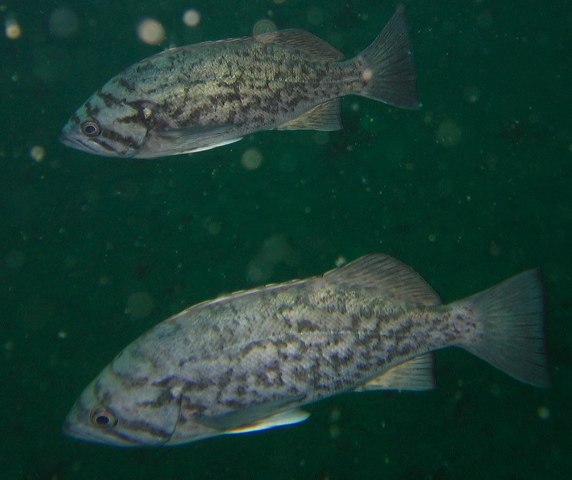
Sebastes auriculatus - Brown Rockfish
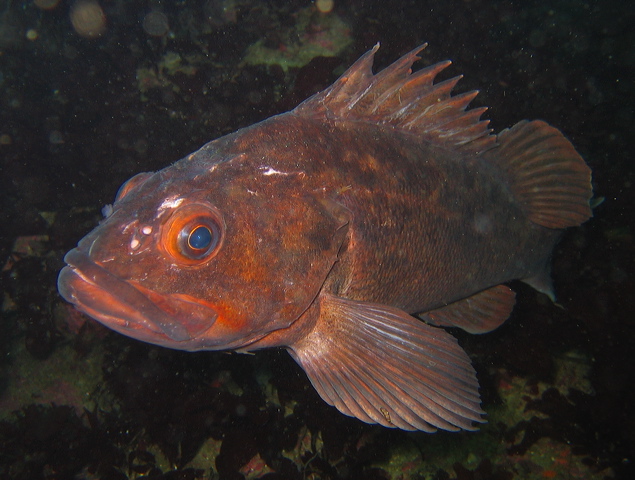
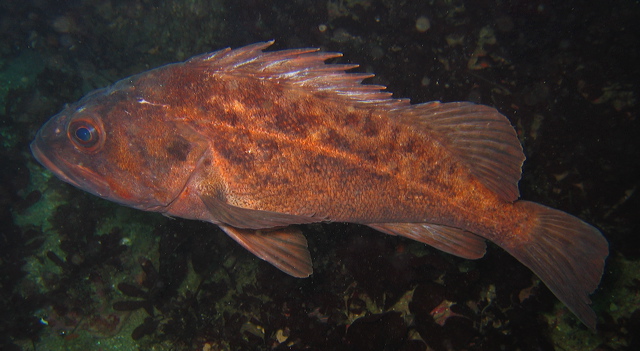
Sebastes nebulosus- China Rockfish
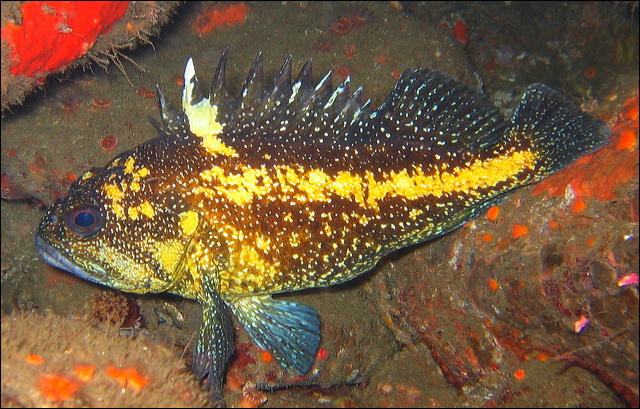
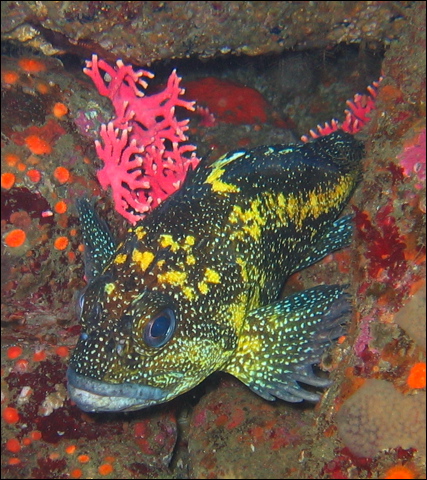
Sebastes caurinus - Copper Rockfish
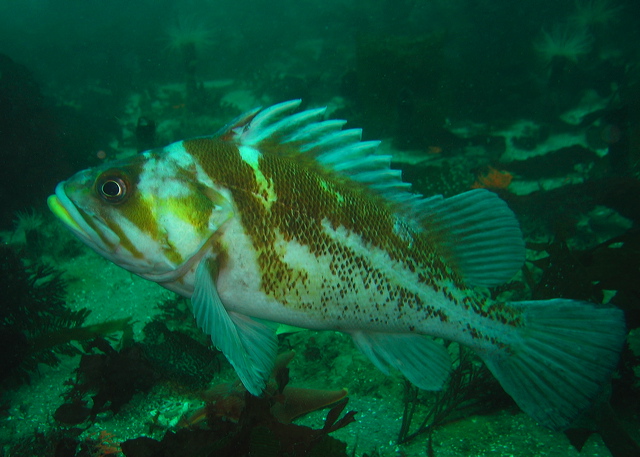
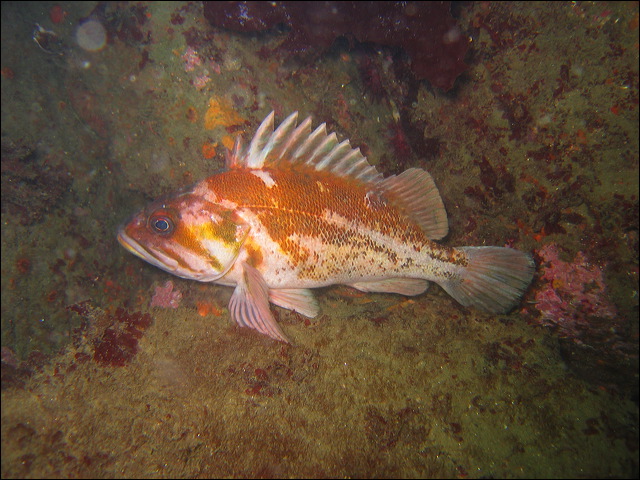
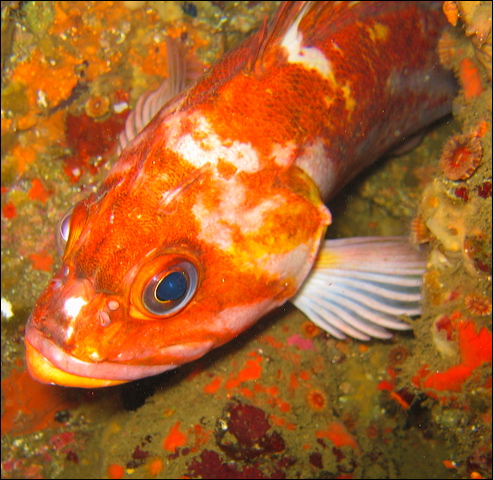
Sebastes carnatus - Gopher Rockfish
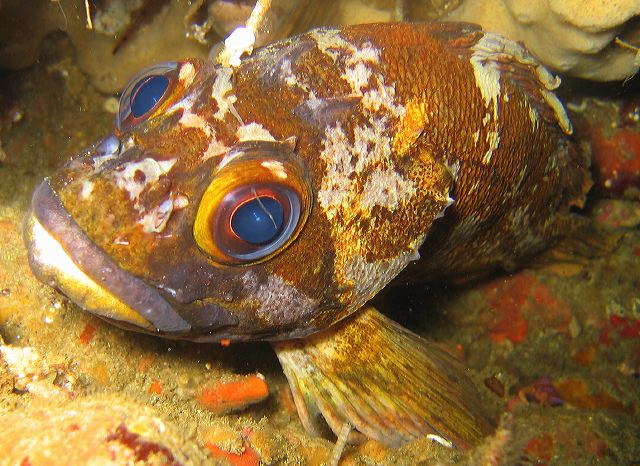
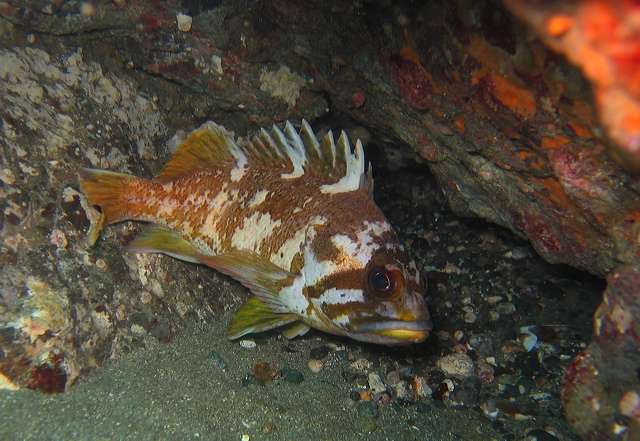
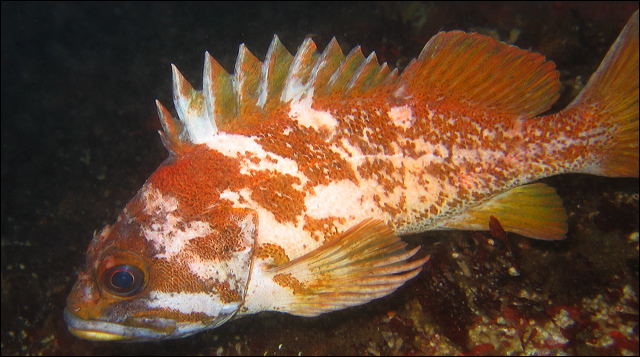
Sebastes rastrelliger - Grass Rockfish
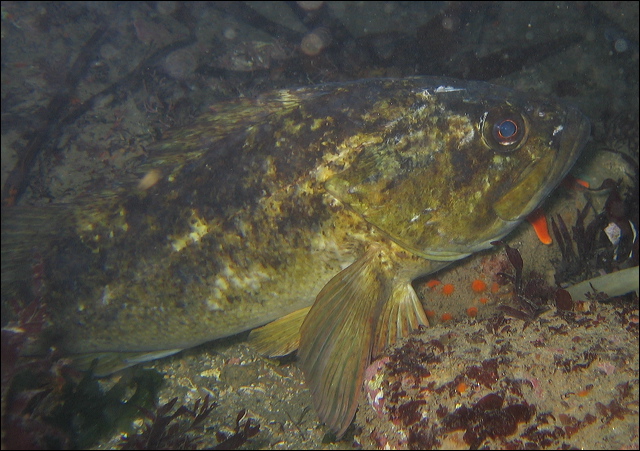
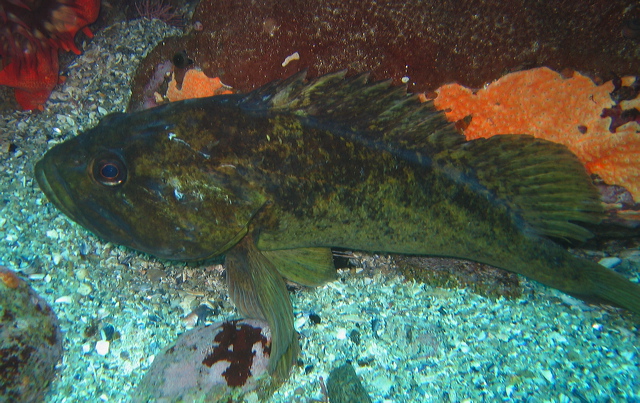
Sebastes atrovirens - Kelp Rockfish (aka Dumbass)

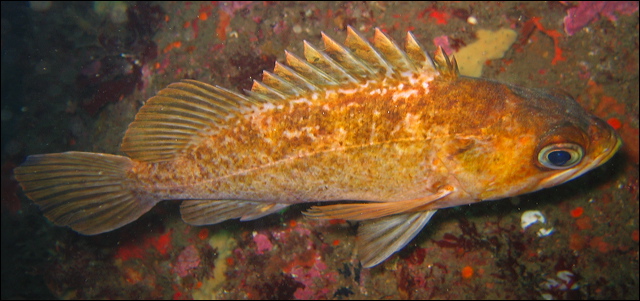
Sebastes flavidus or Sebastes serranoides - Yellowtail or Olive Rockfish
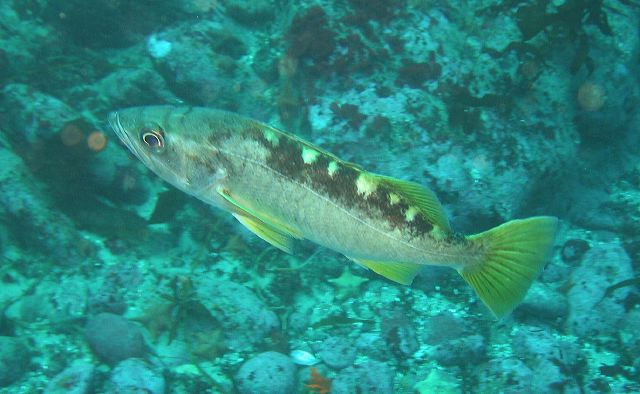
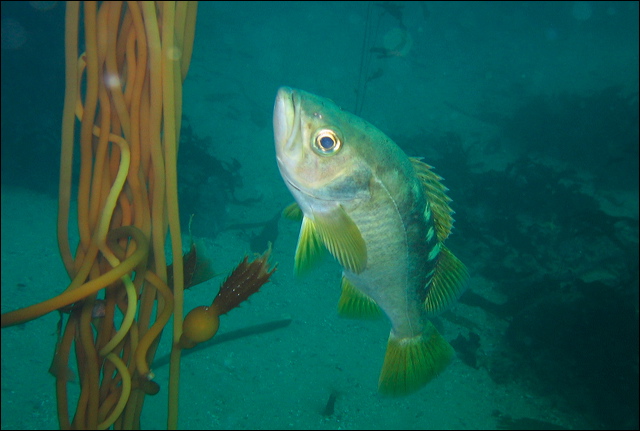
Sebastes rosaceus – Rosy Rockfish
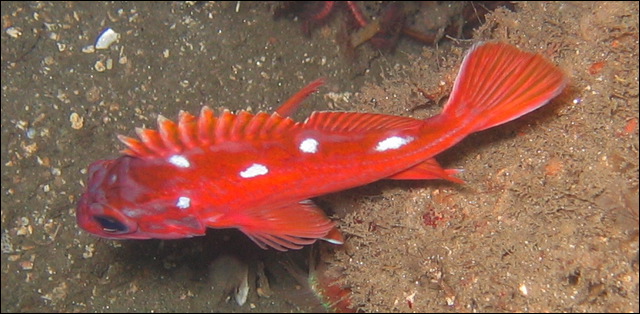
Sebastes serriceps - Treefish
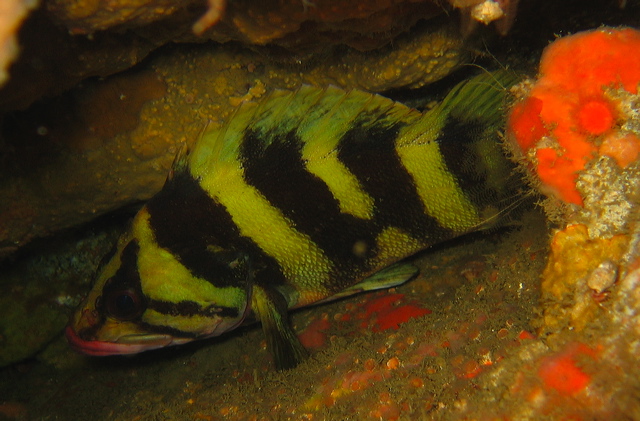
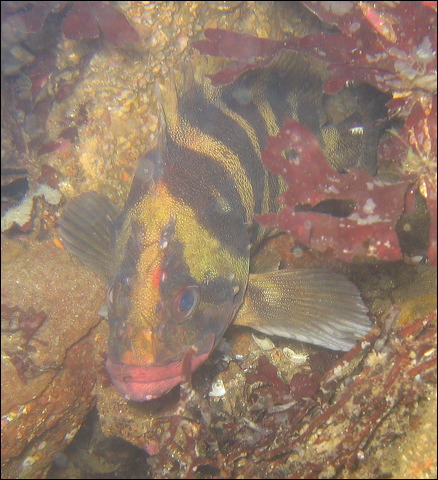
Sebastes miniatus - Vermilion Rockfish
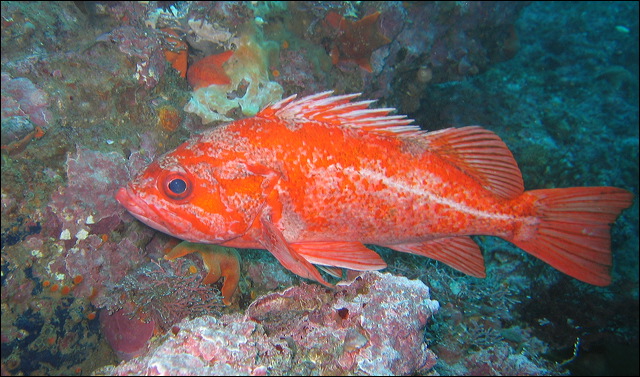

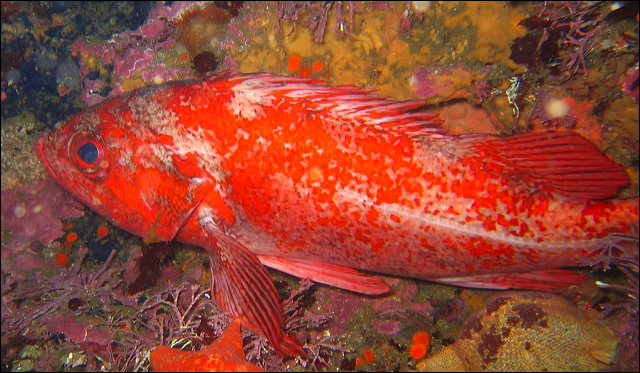
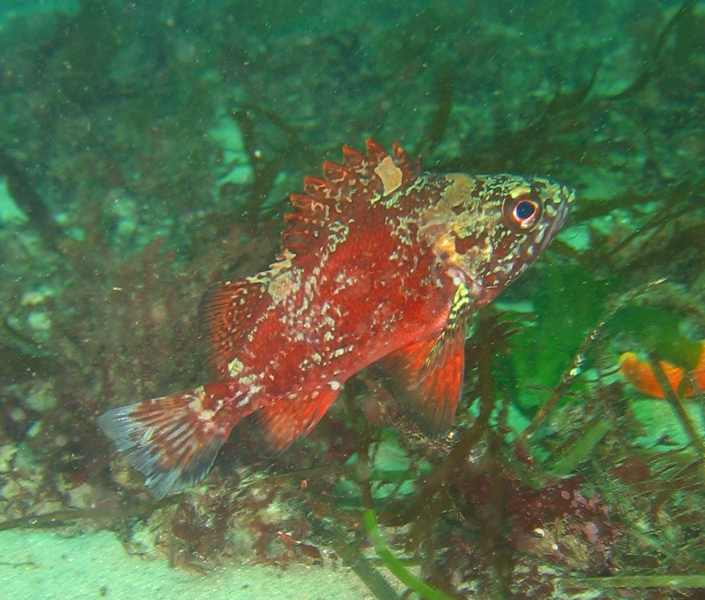
Juvenile Vermillion Rockfish, approx 1-2 years old.
Surfperch – Embiotocidae
Surfperch has a laterally compressed body of football-shape with forked tail fin. Average size is around 0.5 – 1 foot, average age is around 5 – 10 years. They live both in midwater or near the bottom as solitary individuals or in groups. As indicated by the family name, Embiotocidae, Surfperches give live birth, some produce up to 100 youngs. Their diet consists of invertebrates: crabs, shrimps, worms, snails, mussels; cormorants prey on them.
Embiotoca jacksoni - Black SurfPerch
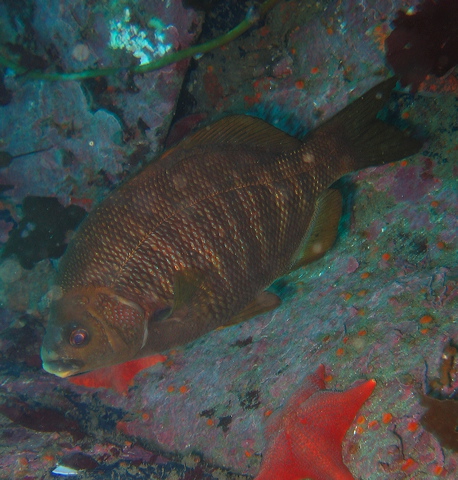
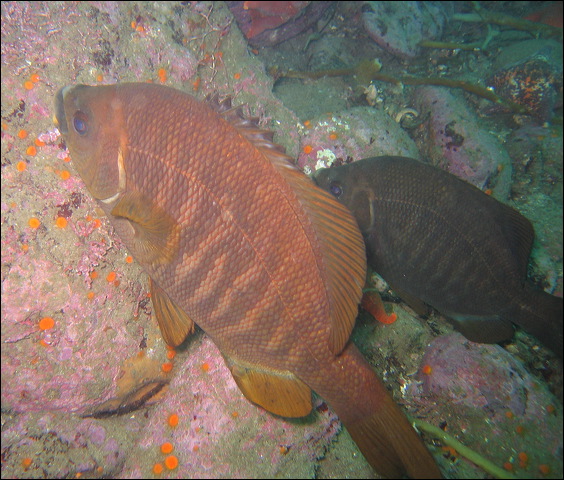
Embiotoca lateralis - Striped Surfperch

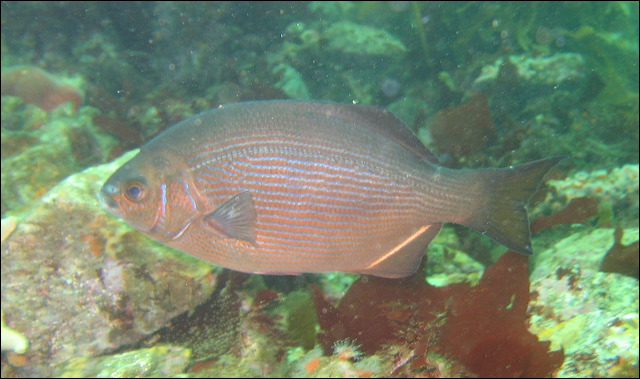
Hypsurus Caryi - Rainbow Surfperch
Rhacochilus vacca - Pile Surfperch
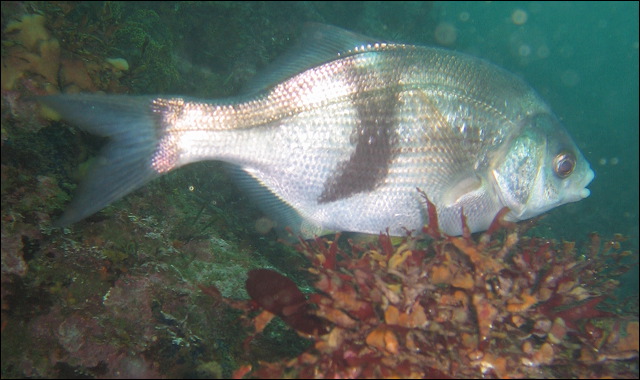
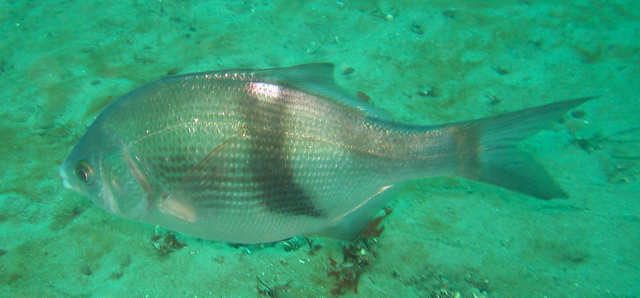
Rhacochilus toxotes - Rubberlip Surfperch
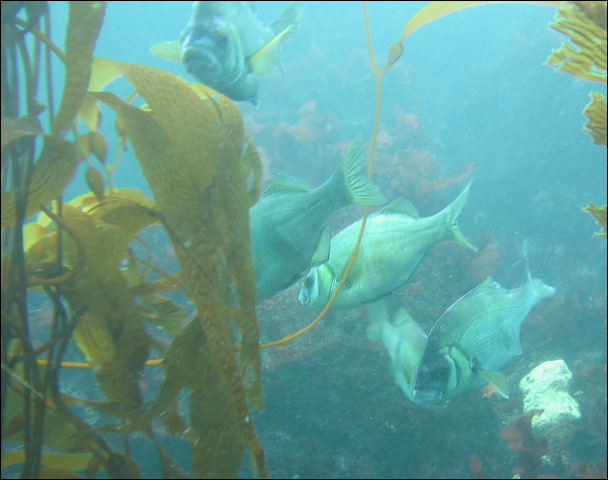
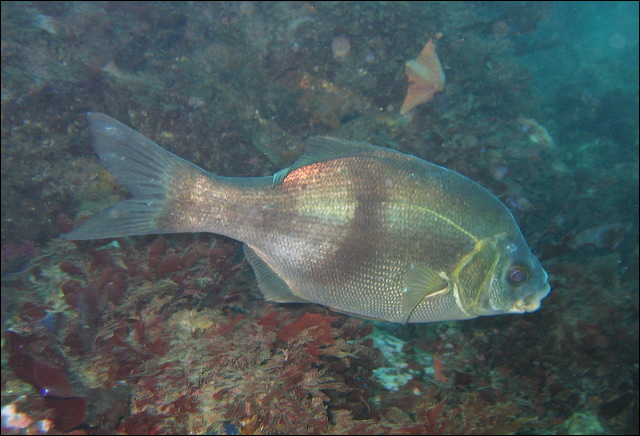
Hyperprosopon argenteum – Walleye Surfperch
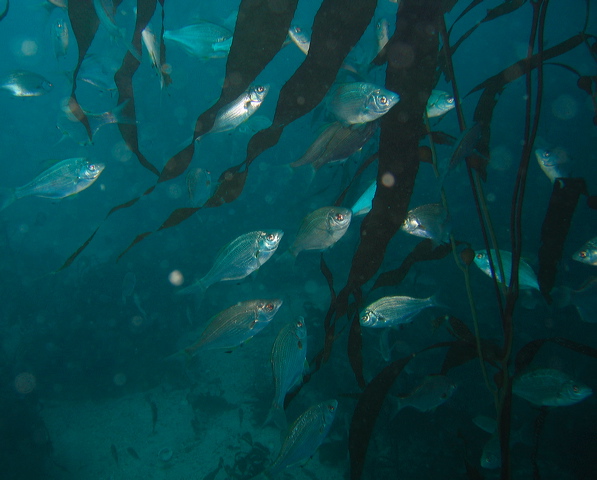
Greenling - Hexagrammidae
This group contains some of the favorite fish of local divers, lingcod and kelp greenling. They have elongated body, lingcod can grow up to 5 feet. Male guards eggs.
Hexagrammos decagrammus - Kelp Greenling (male)
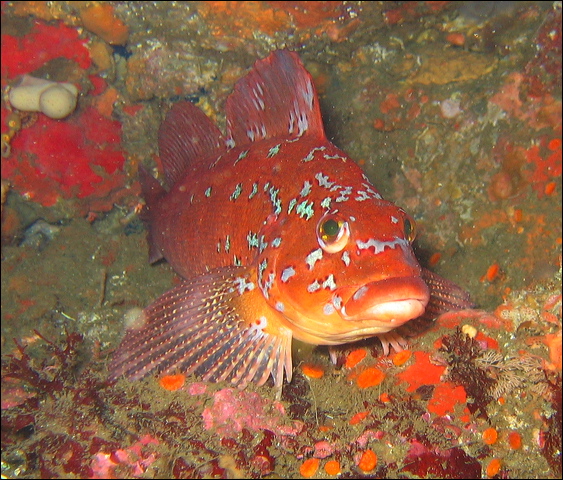
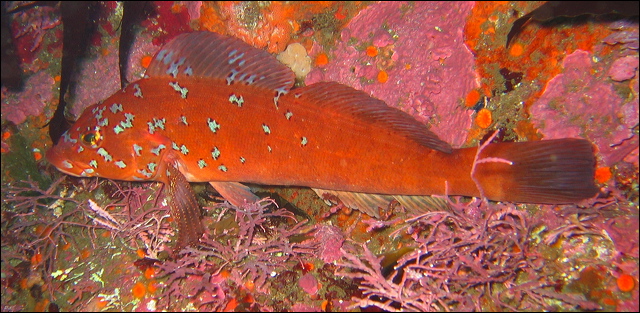
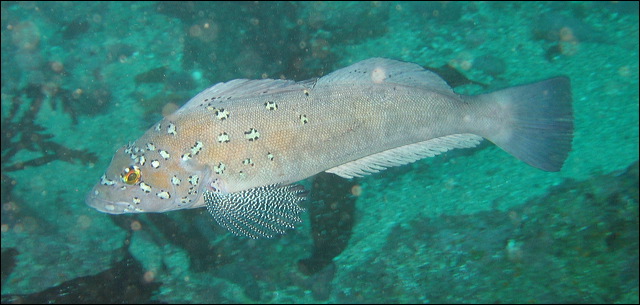
Hexagrammos decagrammus - Kelp Greenling (female)
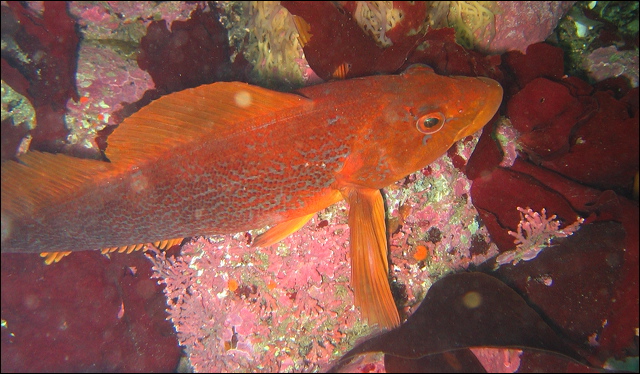
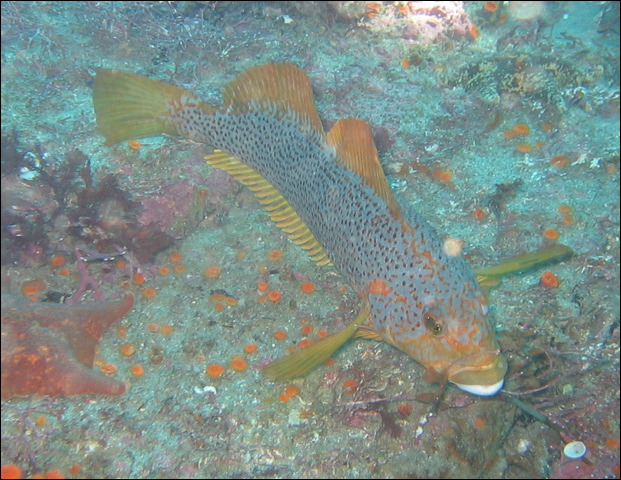

Oxylebius pictus - Painted Greenling
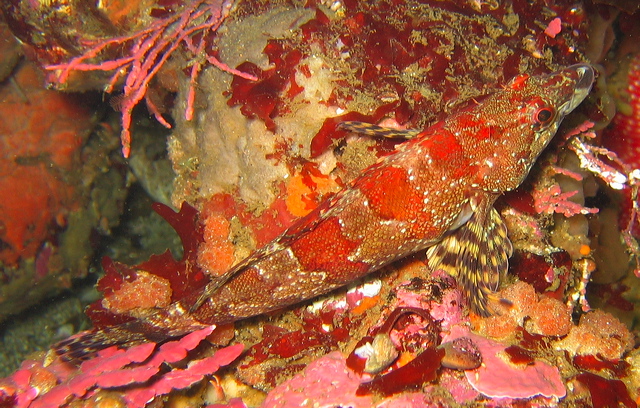
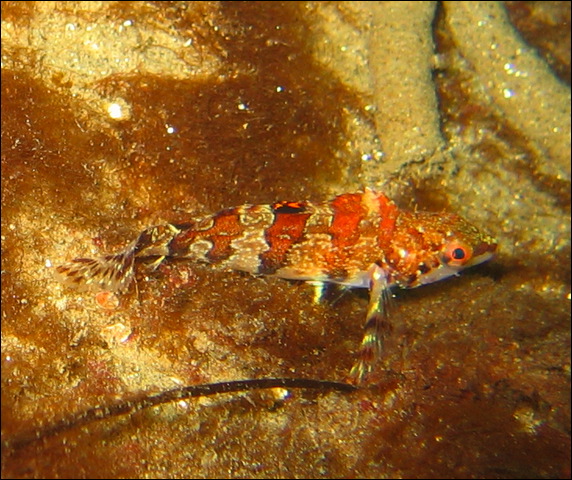
Ophiodon elongatus - Lingcod
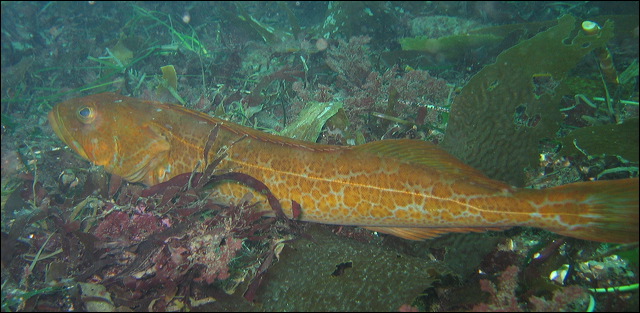
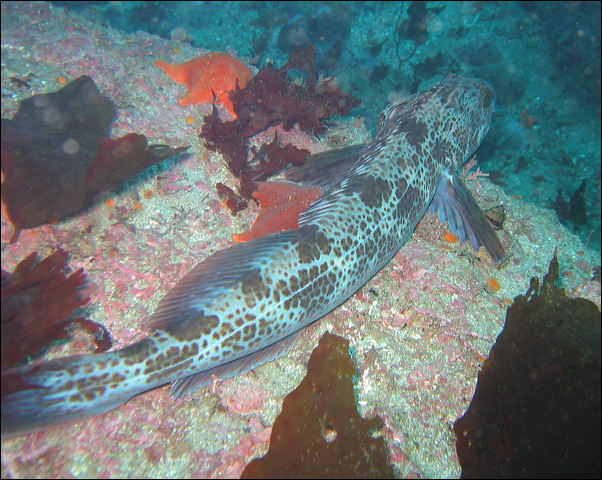
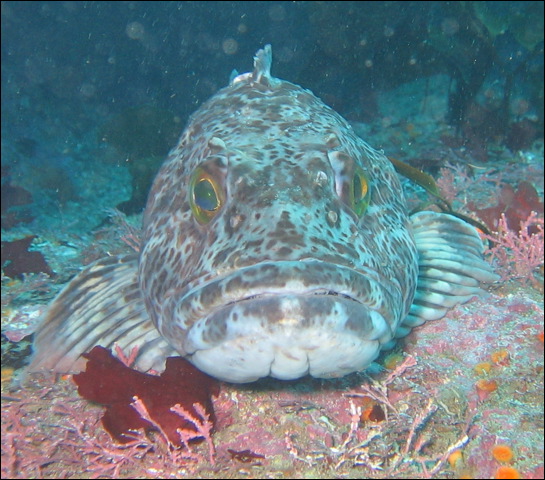
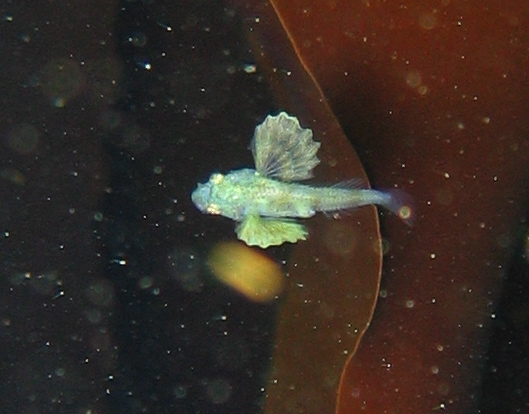
Juvenile Lingcod less than a year old.
Wrasse – Labridae
Wrasses are sexually dimorphic, i.e. male and female look quite distinct. Many species are sequential hermaphrodites, they change sex from female to male. Male are territorial displaying distinctive coloration.
Many wrasse species are cleaner fish, e.g. our Senorita, picking parasites and dead tissues from other fish.
Semicossyphus pulcher – California Sheephead (male)


Semicossyphus pulcher – California Sheephead (female)
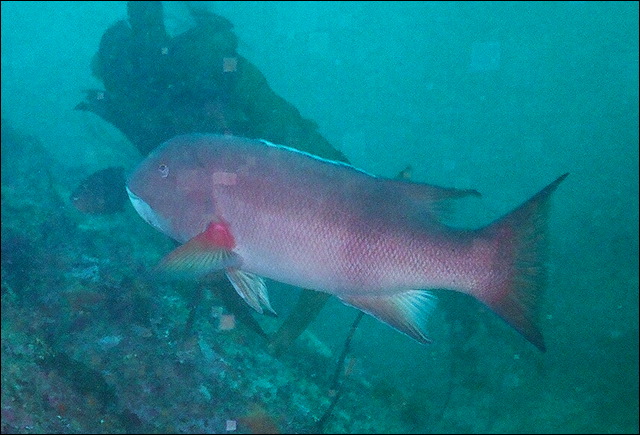
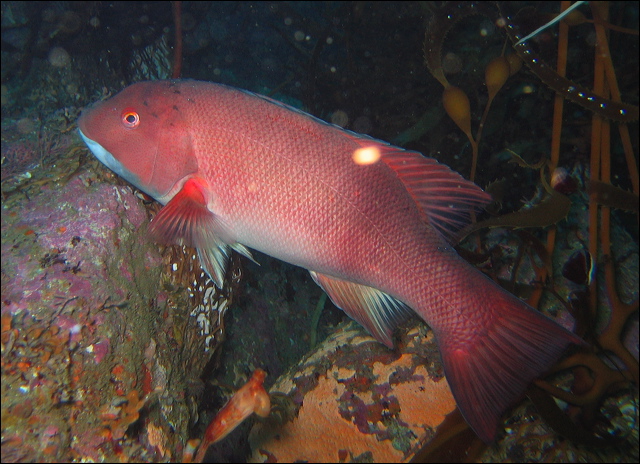
Oxyjulis californica - Senorita
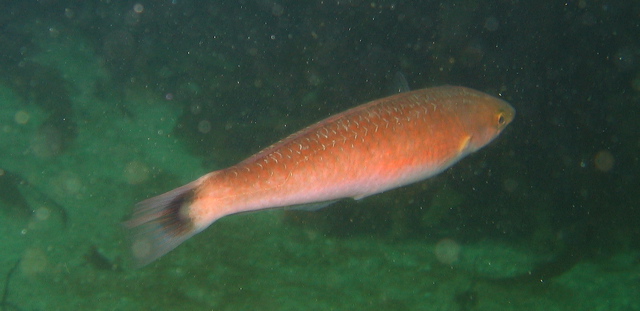
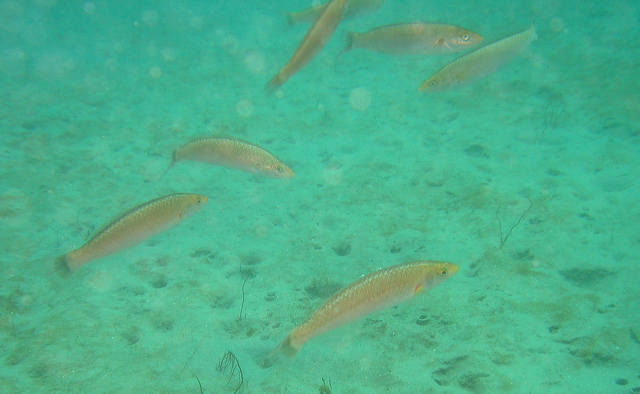
Bass – Serranidae
Paralabrax clathratus - Kelp Bass
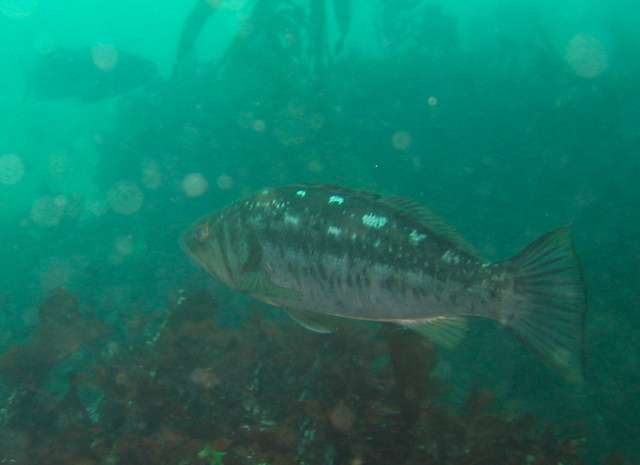
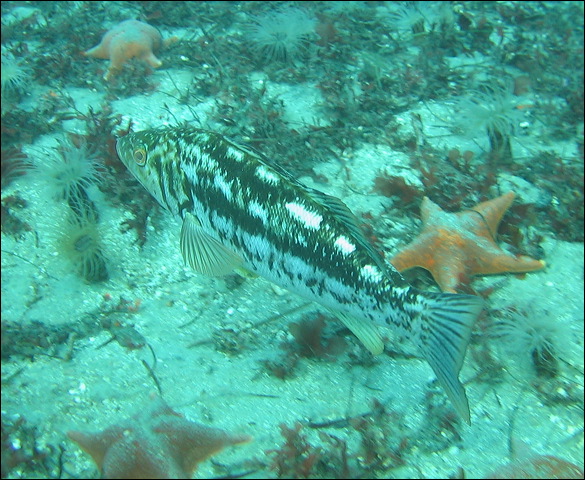
Sculpin - Cottidae
Most sculpin in our waters are small, 2- 6 inches, live only 2 – 5 years. Exception is the Cabezon that may grow to more than 2 feet and live more than 13 years. They are bottom dwellers resting on their large pectoral fins, well camouflaged, some may change color to match surroundings. Male guards eggs.
Artedius corallinus - Coralline Sculpin
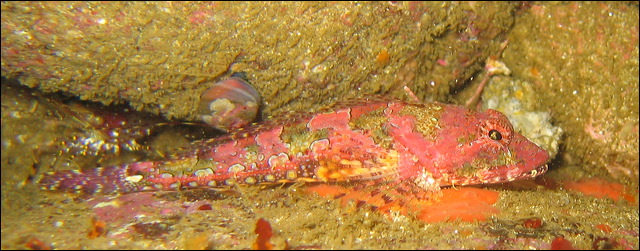
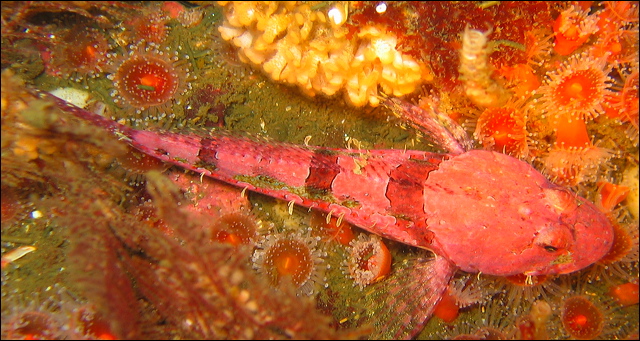
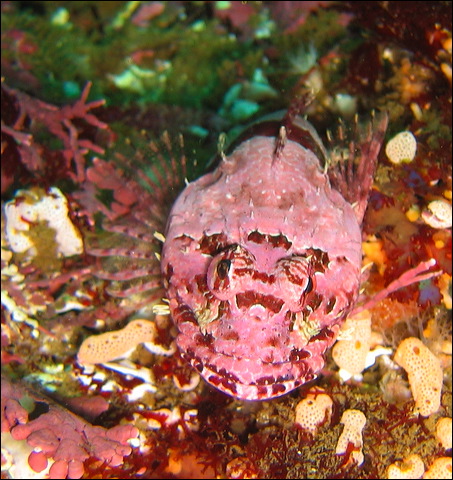
Icelinus tenuis – Spotfin Sculpin
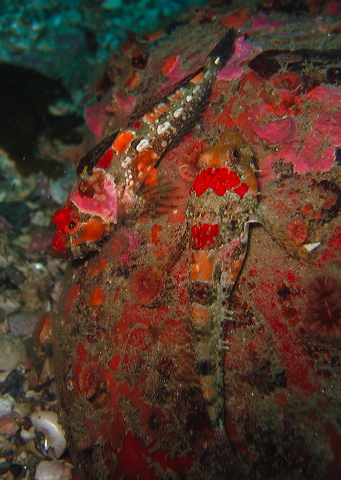
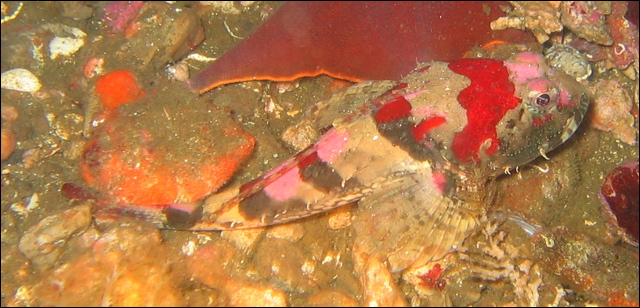
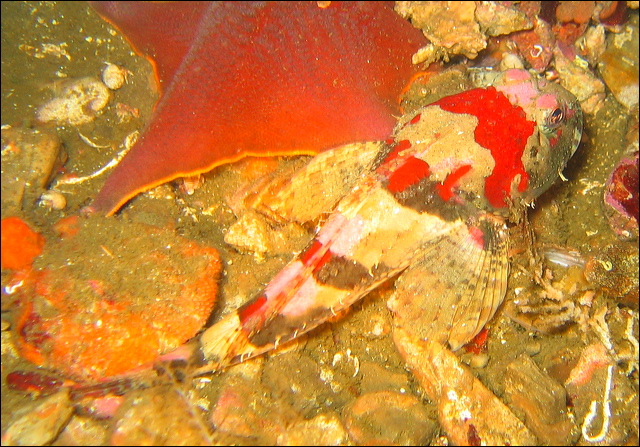
Jordania zonope - Longfin Sculpin
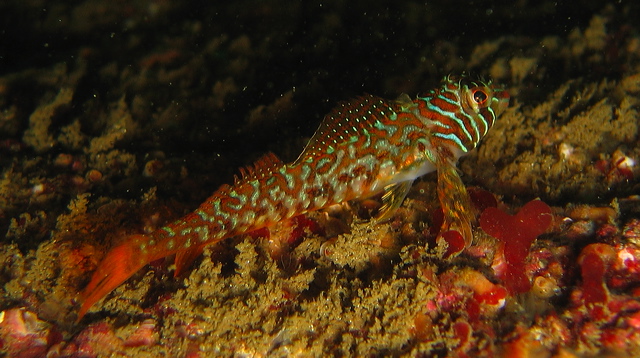

Orthonopias triacis - Snubnose Sculpin
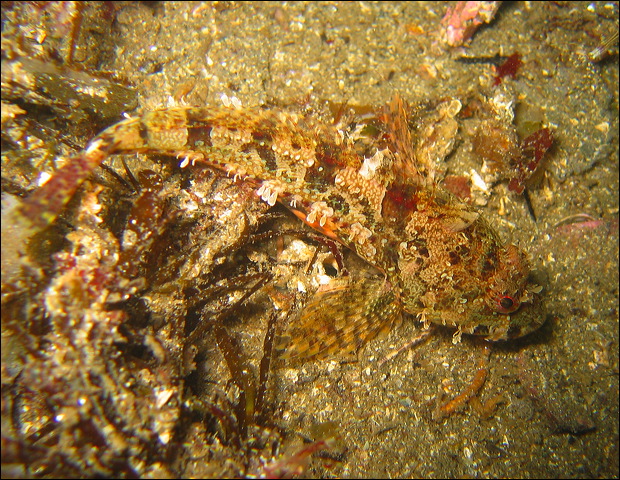
Leptocottus armatus - Pacific Staghorn Sculpin
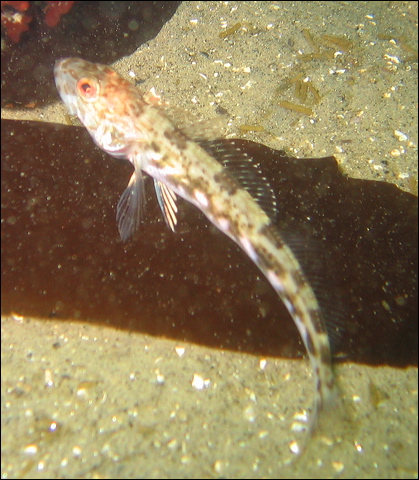
Synchirus gilli - Manacled Sculpin

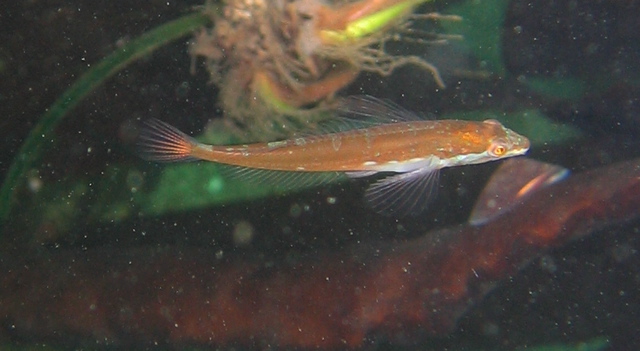
Scorpaenichthys marmoratus - Cabezon

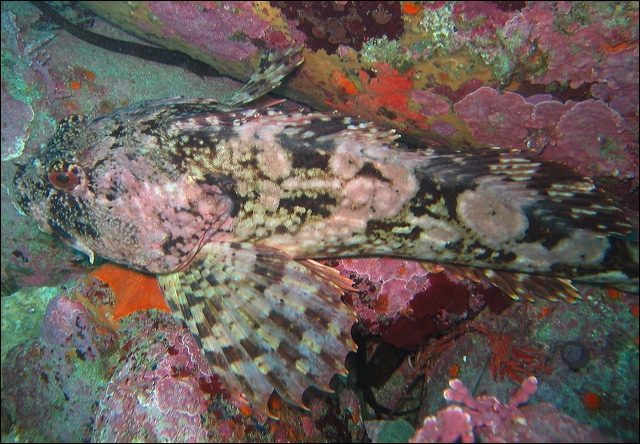
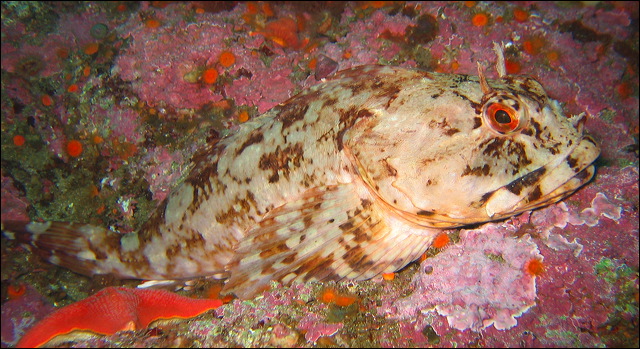
Goby - Gobiidae
Rhinogobiops nicholsii - Blackeye Goby
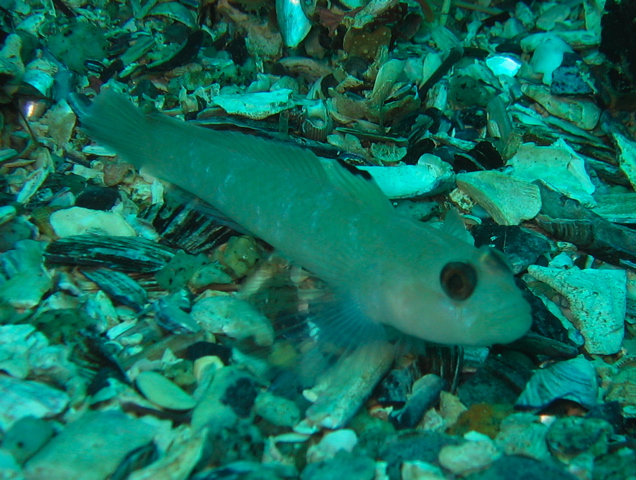
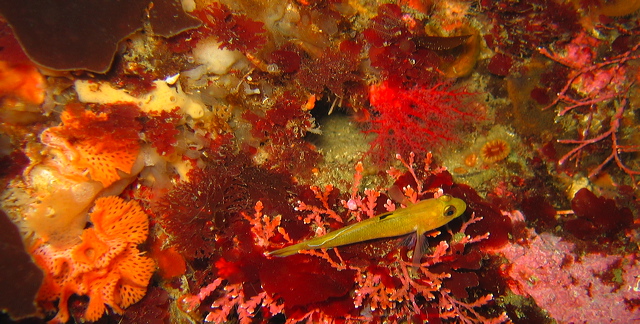
Lepidogobius lepidus - Bay Goby
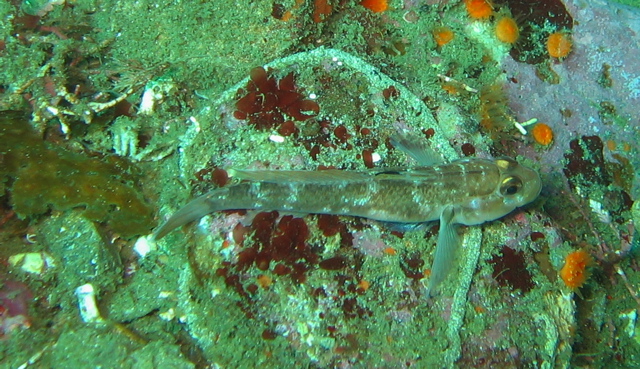
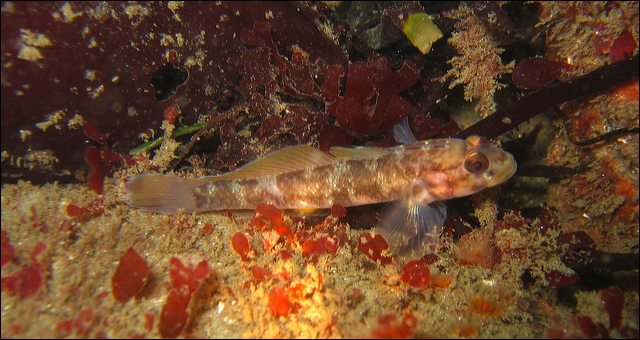
Kelpfish – Clinidae
Gibbonsia montereyensis – Crevice Kelpfish
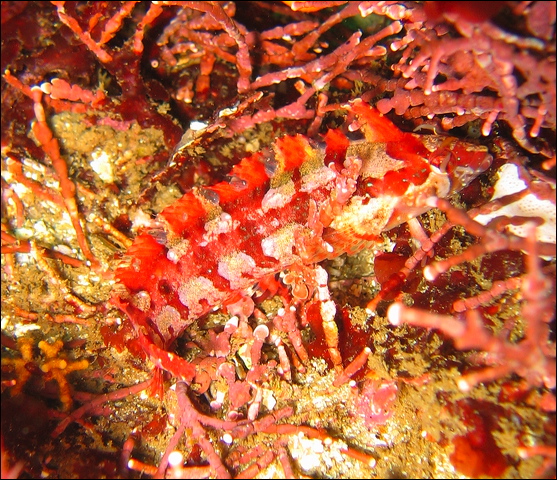
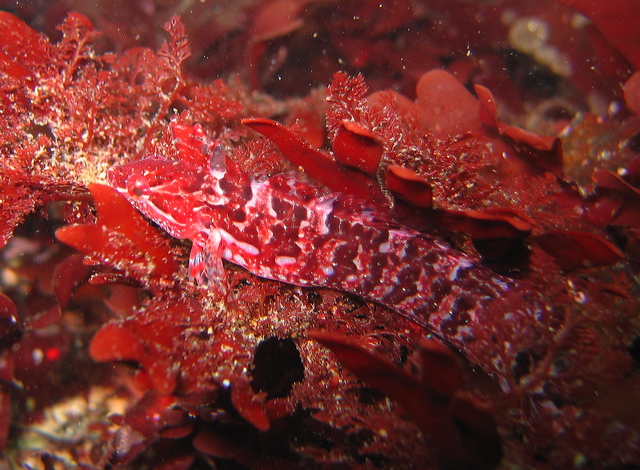
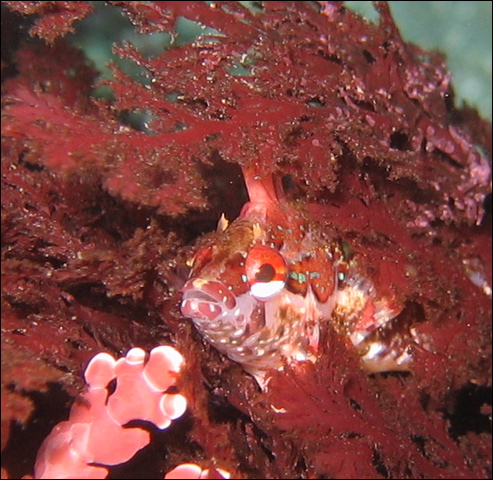
Gibbonsia elegans – Spotted Kelpfish

Heterostichus rostratus - Giant Kelpfish
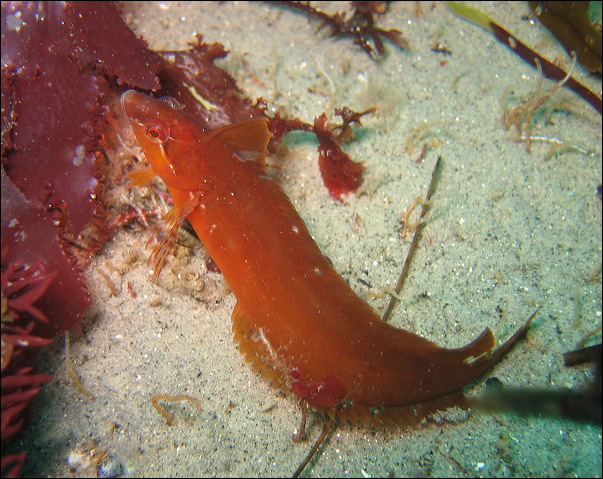
Neoclinus uninotatus - Onespot Fringehead
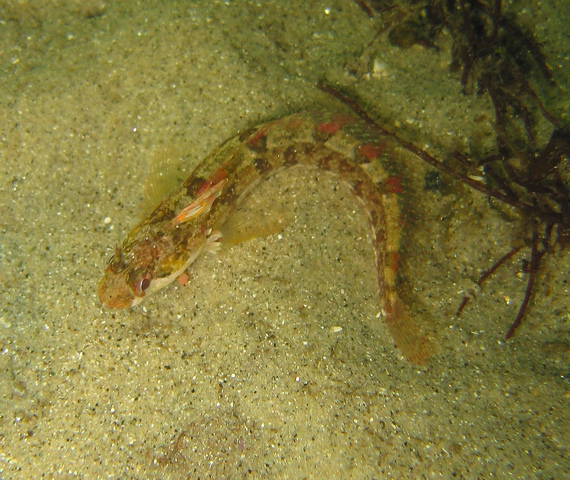
Flounder – Pleuronectidae and Bothidae
Flatfish belong to the Order Pleuronectiform, the name means side swimmer. Most flatfish species in our area belong to two families. They are distinguished according to which side the fish lays on and which side the eyes are on: Pleuronectidae have their eyes on the right side while Bothidae on the left side. The bilaterally symmetrical larva of this group undergoes an amazing change in early development: one of the eyes migrates to the other side through the skull. The side with the eyes is exposed and develops a color pattern, while the other side, next to the bottom, remains white. This evolutionary adaptation makes them perfect bottom dwellers, well camouflaged, often buried in the sand or sediment. Many species in this group are important in human consumption: halibut, turbot, sole, flounder, sanddab.
Paraplagusia bilineata – Rock Sole

Platichthys stellatus - Starry Flounder

Pleuronichthys coenosus – C-O Turbot
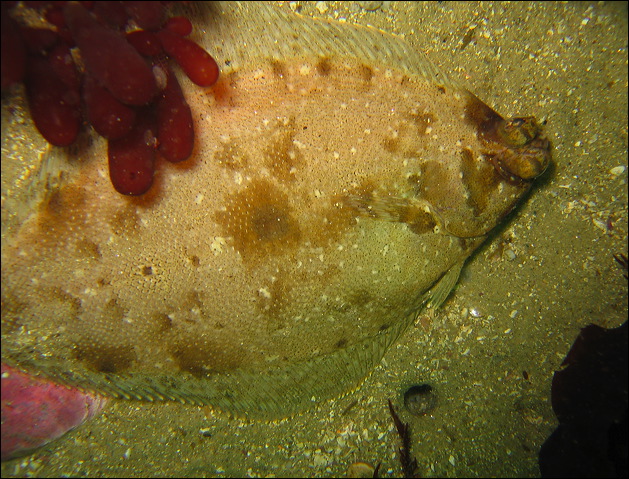
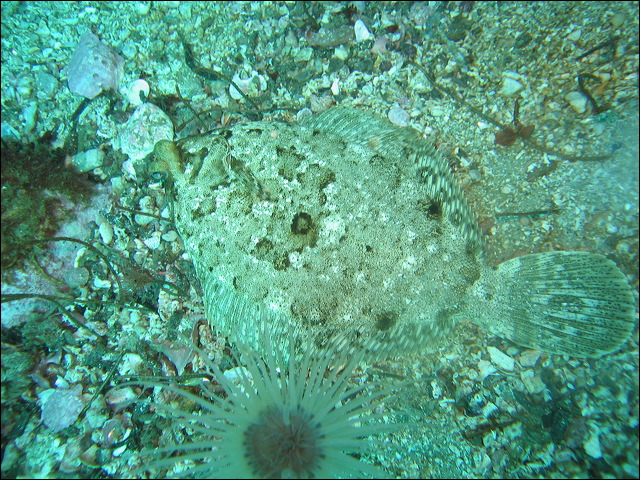
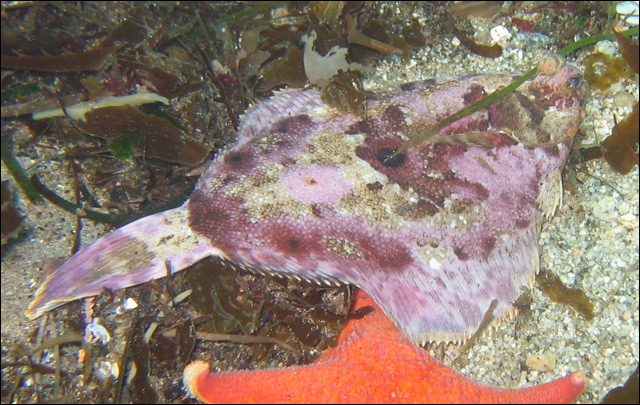
Citharichthys stigmaeus - Speckled Sanddab
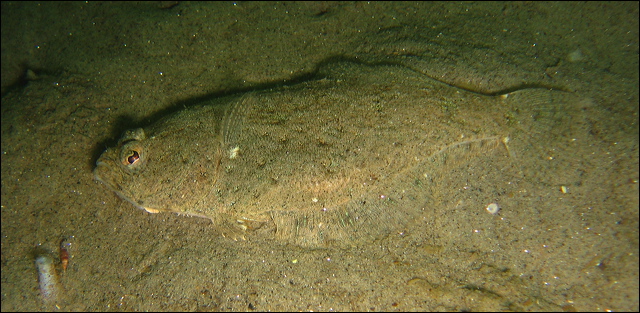
Eel-like
True eels are members of the order Anguilliformes, e.g. Morray Eel, but none of the following species are true eels. They all have elongated body with long dorsal and anal fins.
Cebidichthys violaceus - Monkeyface Prickleback
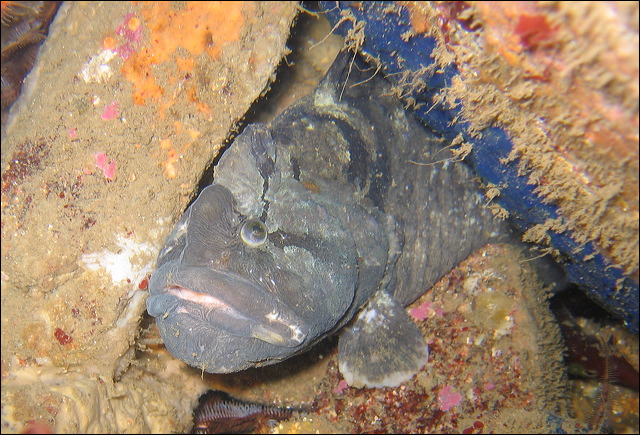

Chirolophis nugator - Mosshead Warbonnet
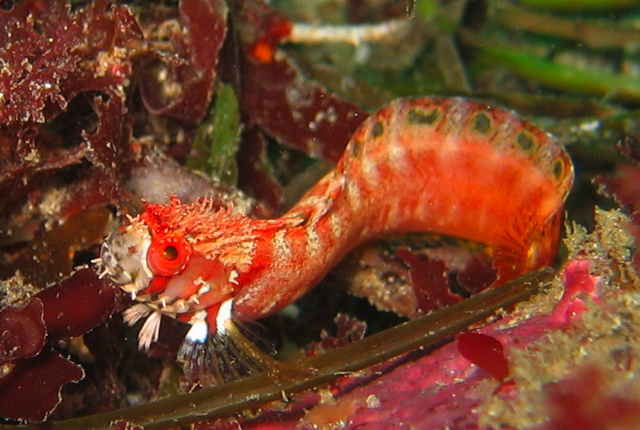
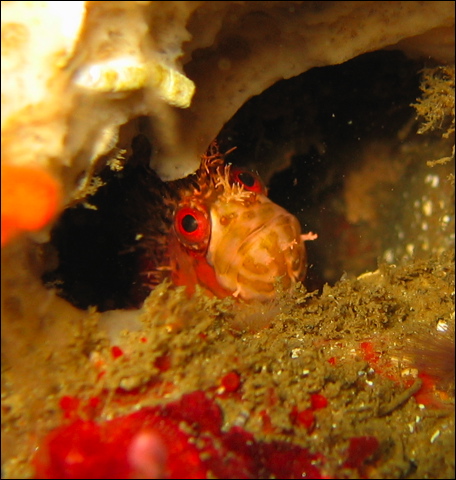
Kasatkia Seigeli - Six Spot Prickleback
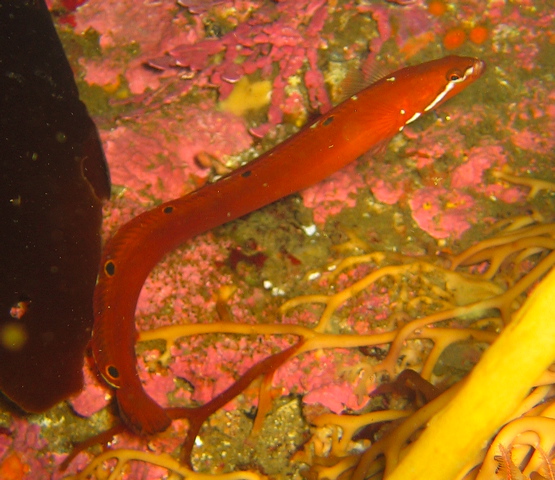
Ernogrammus walkeri - Masked Prickleback
Generally nocturnal, rarely observed.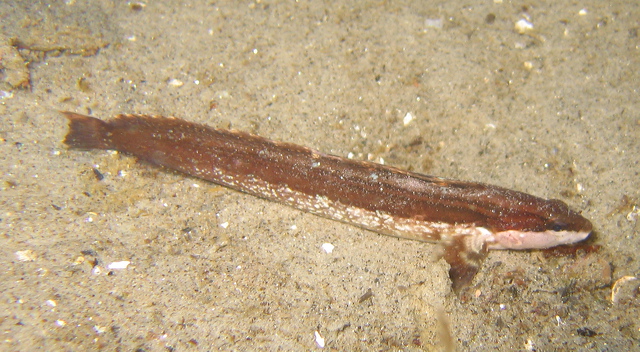
Anarrhichthys ocellatus - Wolf Eel (Male - Gray, Female - Brown)
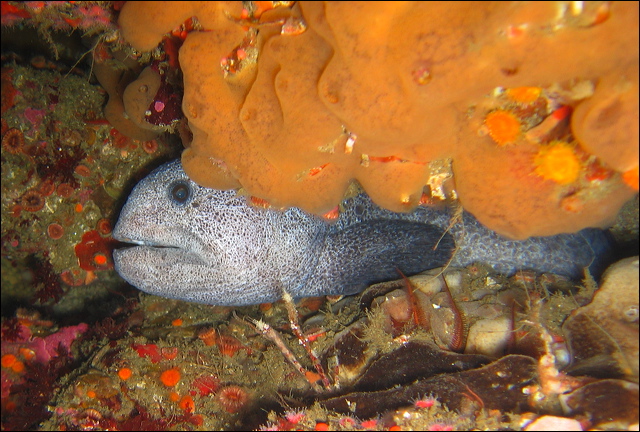
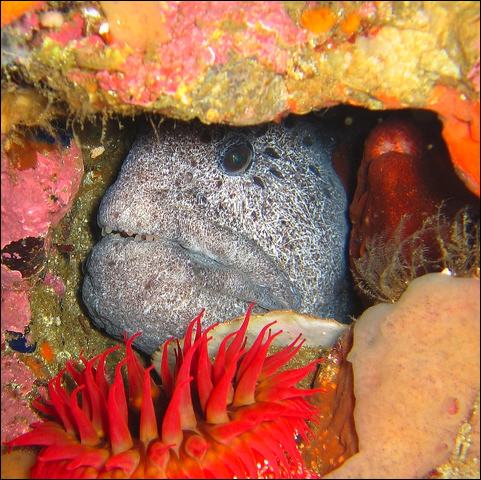
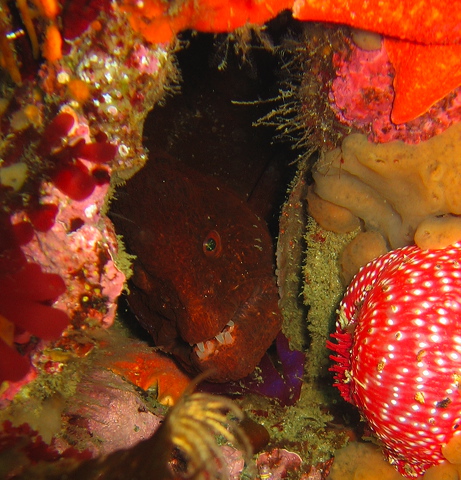
Cusk Eel ??
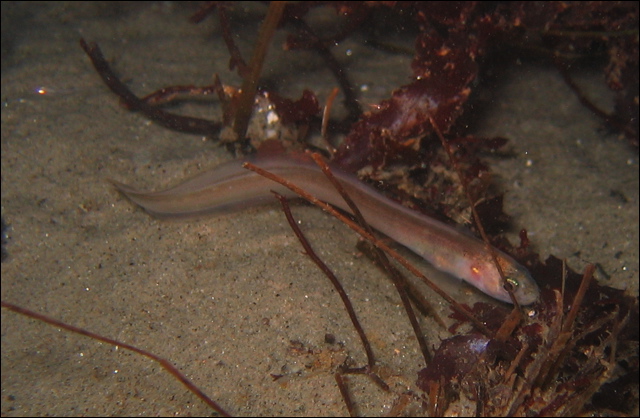
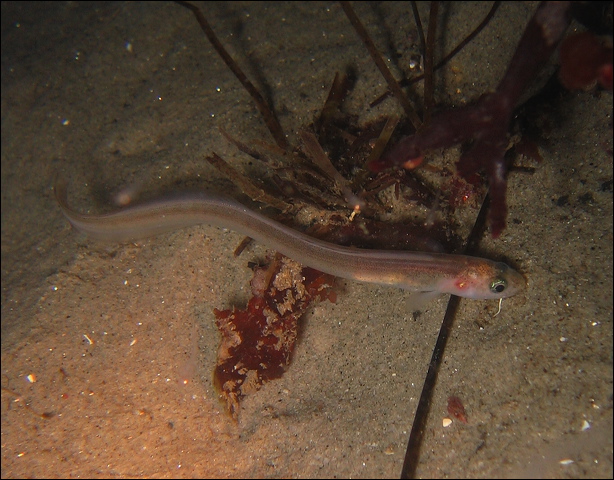
Miscellaneous
Rathbunella hypoplecta - Stripedfin Ronquil
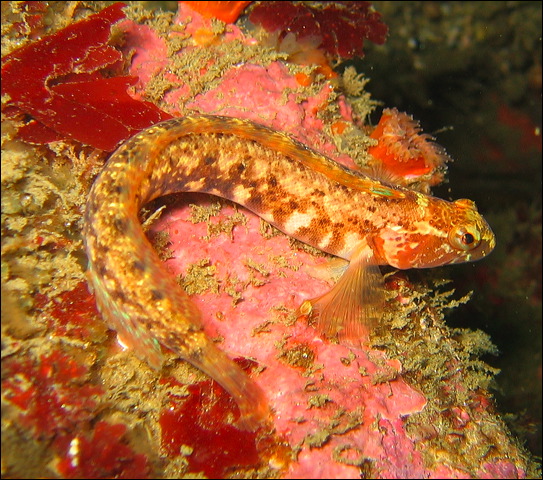
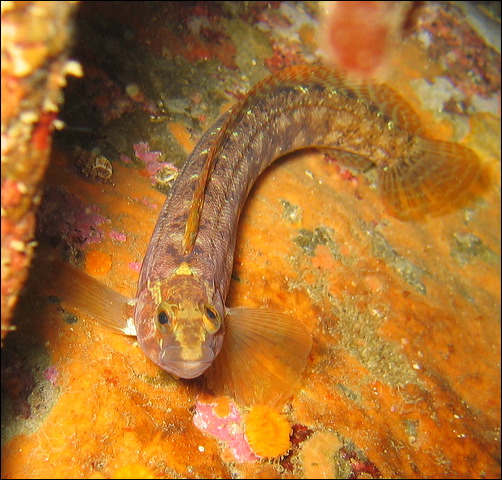
Chromis punctipinnis - Blacksmith
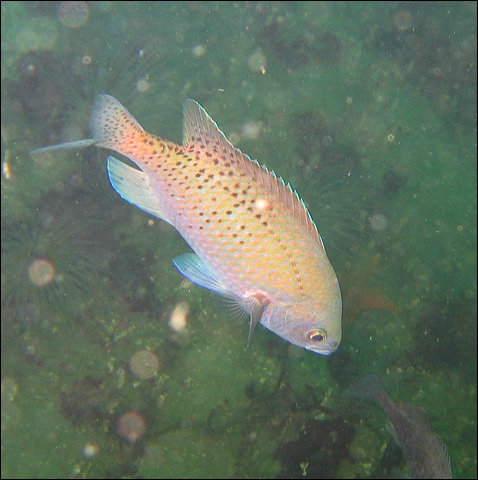
Syngnathus leptorhynchus - Bay Pipefish
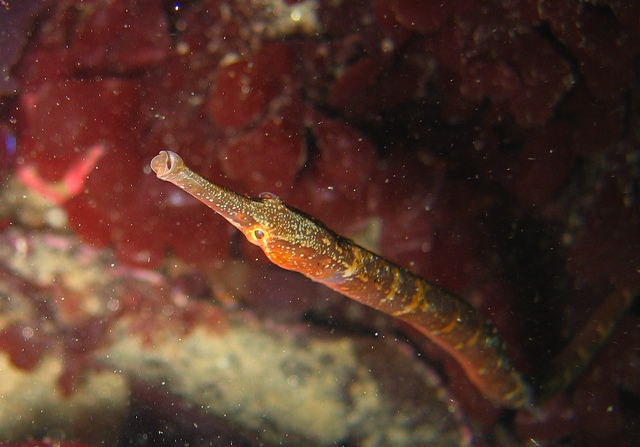
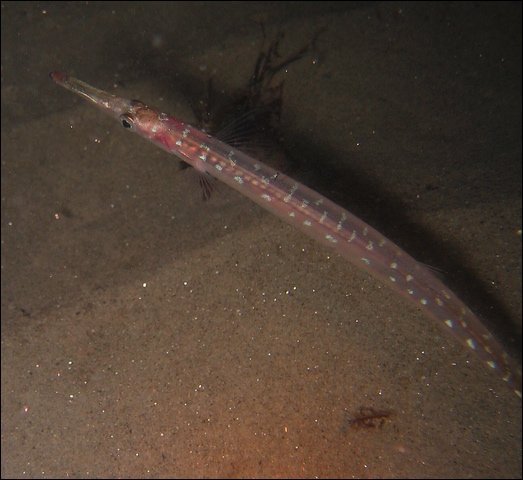
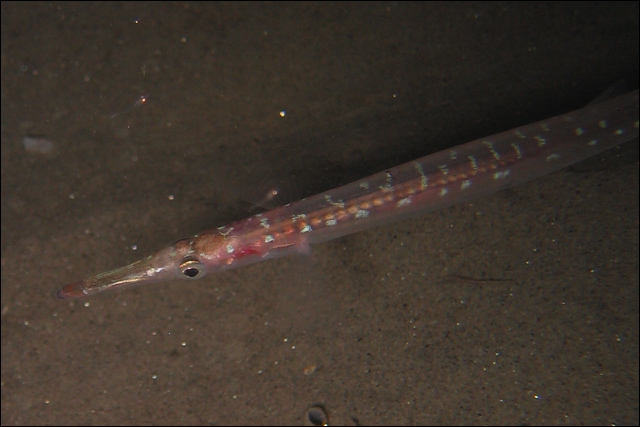
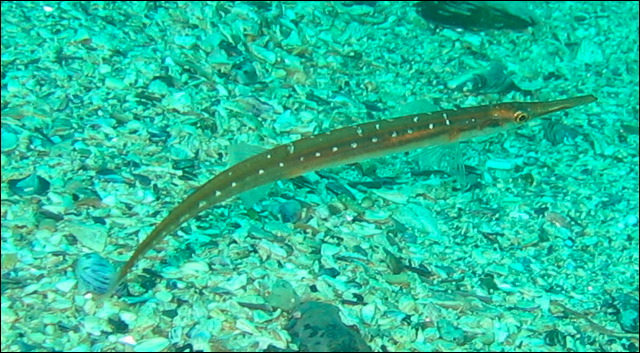
Mola mola - Ocean Sunfish
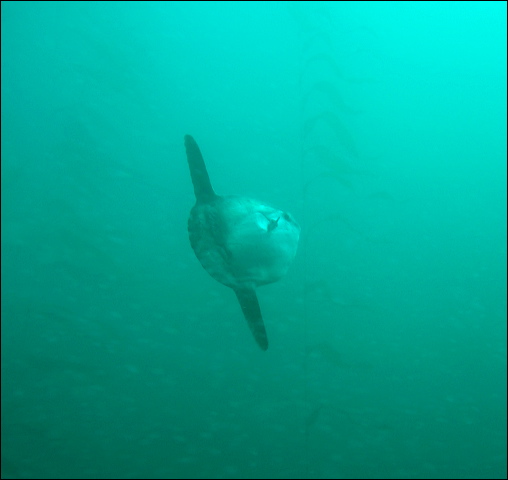
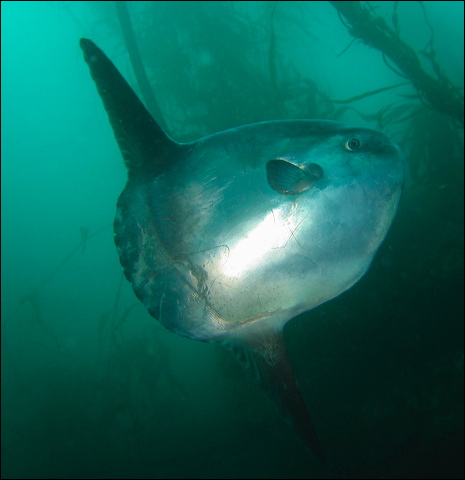
Updated: 12 July 2011

